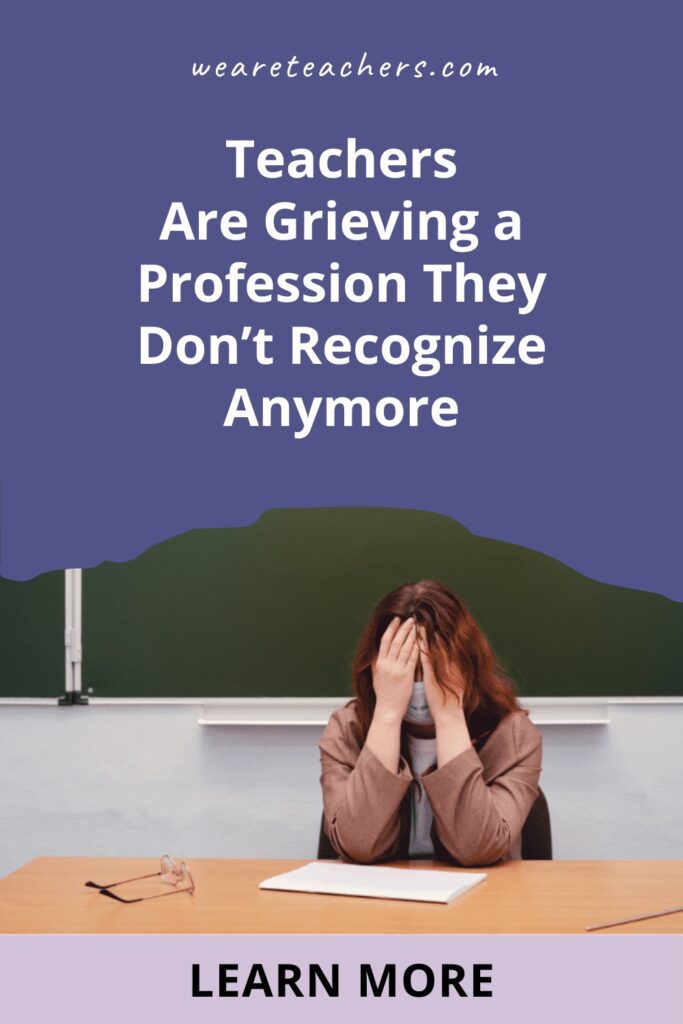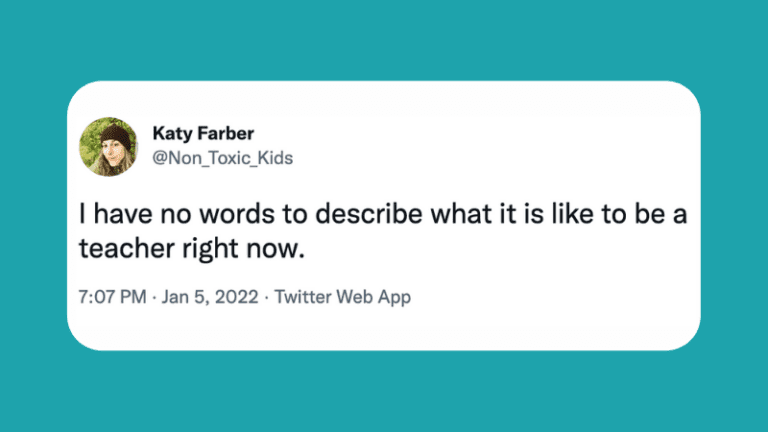I taught middle school English for over a decade, but like many teachers, I left the profession after last year.
I still feel like a teacher in a lot of ways. I still catch myself saying I’m a teacher when people ask what I do (which, weirdly, still feels accurate). I still think, I need that! when I see cute teacher decor or storage containers on sale even though I don’t have a classroom.
And without even being a teacher, I can still feel—acutely—the collective heaviness of teachers this year.
I hear it in the sighs and tones of my teacher friends, even ones who love their schools. I see it on social media—Reddit threads, new teacher Facebook groups, and tweets from Teacher Twitter. I feel it when I see that even the brightest lights I know in the teacher universe are flickering.
But this heaviness is distinctly different to me than in other years.
This is not the grueling sprint in 2020 where we were all scrambling to figure out distance learning, teaching through masks, and holding space for our kids as they lost all semblance of normalcy.
This is not 2021 where we lost count of school shootings, went from being heroes to groomers, and began to see the disturbing effect the pandemic had on children’s mental health and behavior.
We are in the aftermath of all of that. After sorting through the rubble from the past several years, many teachers have realized they have lost the profession they knew. What’s left is something altogether different and unrecognizable.
This is now a profession in which teachers are required to participate in trauma—their own and that of kids.
We ask children and teachers to pretend they’re hiding from someone trying to kill them on a regular basis. And according to a recent study from Georgia Tech, “Active shooter drills in schools are associated with increases in depression (39%), stress and anxiety (42%), and physiological health problems (23%) overall, including children from as young as five years old up to high schoolers, their parents, and teachers.”
This is no longer a profession that teaches students the truth.
In a post-truth era, teachers no longer have the ability to tell their students what’s true and what’s not. Parents can opt out of history lessons, books, and other discussions that aren’t “their truth.” Students can insist that it wasn’t them on the security camera holding the spray paint can, and that actually it was the teacher’s fault they plagiarized because the assignment was so hard.
This is now a profession where many students—who used to be our reprieve from the toughest parts of the job—are hurting and angry.
They’re tearing up schools, themselves, and each other. And teachers can’t help them. They don’t have the manpower for huge class sizes, the training of a therapist, or the resources at school to support them in meeting their needs.
The workload of this profession went from already difficult to impossible.
Teacher and sub shortages are leaving remaining teachers with bigger classes and less planning time than ever. Many states are responding to this shortage by ushering unqualified, inexperienced people into classrooms.
This is no longer a profession in which teachers can take adequate care of their families or themselves.
In many parts of the United States, a teacher who is the sole breadwinner of a family of four makes below the poverty line. Low pay, paltry benefits programs, and sub shortages makes it harder than ever for teachers to have their health needs met.
Teachers aren’t just struggling, they’re grieving.
I don’t know what will happen to education if government leaders and voters continue to ignore what’s happening and apply cheap Band-Aids instead of muscling up and creating meaningful change. We might have to learn the hard way that AI cannot replace teachers. We might have to watch the consequences of K-12 education becoming completely optional.
But whatever happens, I know this: It’s not up to teachers to lead the charge anymore. For too long, we’ve been both the scapegoat for society’s ills and the ones tasked with fixing them. For the teachers who are still in the classroom, simply being there is an act of radical generosity; they’re not also responsible for overhauling the system.
While we do need systemic overhaul, right now the thing I care about are teachers in their grief. Here are some things you can do.
Prioritize yourself. Do not listen to the harmful teacher martyr messaging that asks teachers to burn themselves out for the sake of their students. Listen to what your mind and body are telling you they need, even if that means taking time off or breaking your contract. You will not be able to take good care of others if you are suffering, period.
Consider a temporary or permanent break. Do you need an early spring break? Use those vacation days in January (or sick days! No one has to know!). Do you need a more permanent and immediate break while you figure out finances/retirement? Many retail and house- or dog-sitting gigs pay more than teaching, and you get to (gasp!) leave your work at work. If you want to stay in education but get out of the classroom, we’ve got you covered with these options too.
Know that you’re not alone in this grief. It might feel like you’re the only one feeling this way, but you’re far from it. Many teachers’ contracts prevent them from speaking openly about their feelings about the job. Whether you’re in your first year grieving the loss of what you thought teaching would look like or are in your 38th year grieving the loss of the profession you started in, you don’t carry the weight of these feelings alone.
Poet Naomi Shihab Nye refers to grief as the desolate landscape “between the regions of kindness.” I hope for every teacher’s and student’s sake that we’re on our way out of here.
For more content like this, be sure to sign up for our free newsletters.


